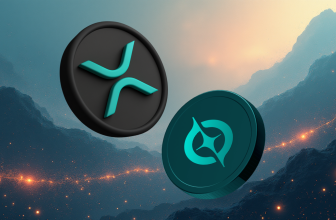
XRP army is one livid crew, they get easily triggered by XRP critical articles. This one is not XRP hate, rather a highlight of little discussed velocity problem that XRP token will face in hypothetical mass adoption scenario.
As Kyle Samani of Multicoin Capital explains it in this seminal piece, token velocity is often overlooked in crypto sector. Basically, all token pitches include a line that goes something like this: “There is a fixed supply of tokens. As demand for the token increases, so must the price.”
This logic fails to take into account the velocity problem.
XRP will be used to pay network fees in the xRapid Ripple Protocol implementation, and can also be used as a bridge currency between institutions. As such, XRP will change hands very fast. Buyers won’t hold the tokens for more than a few minutes at a time. There’s simply no incentive to hold them and incur price risk relative to the dollar.
Here is how token velocity will work in XRP case.
The velocity of a token is a measure of the turn around time between successive uses of the coin/token. If a payment takes 3 seconds, then the daily velocity of the token can reach 24*60*60/3 = 28800 – this in turn means that ‘in principle’ each XRP can be reused 28800 times per day.
In practice we believe that an xRapid transaction is actually holding xrp for 1-2 minutes (lets say 60s for simplicity). That makes the velocity 1440.
The lower velocity should lead to a higher price. When demand on the market (xRapid traffic flow) is high, there will not be enough xrp available if many are locked up or on the wrong exchange. High velocity = lower price. Lower velocity = high price (for xRapid transactions). Lack of availability on an exchange will lead to higher prices (liquidity curves). Source
At 60 secs each XRP is used 1,440 times per day ( 60 minutes X 24 hours ). Lets assume that XRP is at the price of $1….
While you are here, have a look at our Ripple [XRP] price prediction for 2020.
So to use up 1 billion XRPs on a permanent rolling basis, you would need a throughput of $1.44 trillion per day on any given exchange/corridor. (1,440 X 1 billion)
At a price of XRP = $10, the volume exchanged would need to be $14.4 trillion. The whole SWIFT network only has a daily volume of $5 trillion per day.
Lets assume that in 5 years time all the escrow has been released and investors/speculators hold half of all XRP, that leaves 50 billion XRP to be used as transfer of exchange. This means a huge volume of XRP usage would be needed to use up all the XRP and therefore drive up the price of XRP. Source
The above calculations are quite disheartening for the delusional XRP believers who think XRP can reach some unrealistic heights like $5, $10 or even $589 as one popular, unhinged XRP holder predicted on Twitter. XRP token can’t accrue value even if Ripple protocol indeed becomes what the most enthusiastic supporters hope it become – world’s main network for financial transfers.
Since Ripple holds 55 billion of XRP tokens, most of the new entrants into the RippleNet will purchase their XRP from Ripple in OTC markets that do not influence the market price of XRP. What is even worse for XRP holders is that the token might even lose value as those institutions will offload their XRP once they stop needing it for their short-term use.








Your article is an embarrassment to yourself. Just look at how much XRP increases in value due to its ever expanding use cases.
Best advice is go away and do more research
I concur, gibberish. If you have to start the article off with “this is not hate” it probably is.
@David. Agree. Another case of bad news, incorrect news and or more likely, big business trying to dissuade the average guy for their own benefit.
Wow too fast to be worth anything? Just wow. At even a high level do you know what market makers and market takers do all day long? Ok what about Forex? what about OTC? what about store of value?
Now apply the vast many use cases not just the swift paradigm then factor in the terms Slippage and Jevons Paradox
You should really brush up on your subject before publishing. That’s Journalism 101
$5 is an unrealistic height? Weren’t we almost there in Dec/Jan?
That’s quite a silly article.
This isn’t even how xRapid works. xRapid sources XRP liquidity from partner exchanges. The more transactions in motion, the more XRP the exchange has to hold for liquidity use. The institutions utilizing xRapid to move value do not have to hold XRP in order to utilize xRapid. They do not have need or incentive to do so. But the partner exchanges not only have a need to hold but also an incentive. As transactions increase, the amount needed on the exchange to facilitate the transfers will increase. The more XRP held by exchanges, the less that are in circulation, and the higher the price goes. Velocity has nothing to do with any of this. It is a given that velocity is next to instant. Slow coins like BTC are concerned with velocity. But XRP moves so fast velocity is a variable akin to ‘infinity’. The paradigm that involves velocity in valuation does not apply to XRP. There, glad we cleared that up.
I enjoyed your critical and technical thought process, it’s nice to try to make sense of the real time effect of technical limitations but the process of exchange for money transfer isn’t lateral with an exchange in the middle, at least not for Ripple/XRP.
Remember that the price of xrp is independently determined based on supply and demand, via exchanges, which are simultaneously, but independently, affecting the price of XRP. To me, this is mildly concerning because the pace of disbursements of xrp out of escrow will flood the supply, keeping price fluctuations at a minimum. That’s the goal for ripple right? Stability? That was a separate issue though.
Returning to my point, the actual money transfer isn’t a buy or sell transaction, XRP must be owned at the institutional level. Therefore, when aninstitution needs to move $1MM of USD to a Japanese Yen based institution, then the US based institution just sends their own XRP, in the amount equal to the $1MM usd, which is a market set price, and then it’s done, it’s $1MM of XRP off one banks ledger and onto another, with a micro-fraction of XRP burn off for fees. That $1MM of XRP May be a million tokens, or a thousand, etc. but the amount is determined by market forces, set at initiation and acceptance of the transfer. The Xrapid platform facilitates this and claims are it’s the fastest platform out there. So I’m not sure about the velocity, however, the control of disbursements is my biggest concern as basically, there is a market maker.
For that reason, I see a truly decentralized ledger with a mining process behind it, a better alternative for Crypto investors, as far as investing goes. Fortunately or unfortunately, cryptocurrencies are supposed to be exactly that, a currency, and Ripple seems to be playing that card well. I see their token, XRP, as the currency, and Ripple as a fed-like or central bank like entity, able to control volatility. It’s an odd place to be, especially if your hopes are riding high on big riches. The model does make sense though.
Thanks!
Post this on reddit and see what happens.
LOL .. right on!
So by your calculations it could never reach even 5 dollars but by speculation and no use we reached $3.50 go play with your bitcoins.
So… Just how much of SWIFT’s business did Ripple take when XRP hit $3.80?
You have to make a distinction between pure speculative price driving factors and the ones that are predicated on the network growth.
Imbecile. We already hit 3.80 on pure speculation. How clueless are you ?
This FUD seems to keep coming around every dew months when some mathematical wizard thinks he’s clever. Here’s why you’re completely wrong: http://galgitron.net/Post/Is-XRP-Too-Fast-to-Be-Worth-Anything
What if nobody is willing to sell an xrp below $5?
What will velocity do for the banks ? Your article makes no sense ever at all.
Let me explain something to you like we explain little kids :
If an org were supposed to use xrp for transactions – the xrp availablity would be something like this for an example :
100 xrp @ 0.030
Then 50 xrp @ 0.031
Then 360 xrp @ 0.036
And so on.
So as a bank starts buying xrp the value keeps increasing leading to a high valuation.
Just read up more on the topic of token velocity and you are going to be disappointed with your XRP investment, that is a guarantee. I just can’t motivate myself to explain obvious things to delusional holders who literally have no clue what they’re talking about. Go take another hit of hopium, keep your eye-blinder on because once you take it off, you are in for a huge let-down.
I see where you’re going. The use of xrapid will cause the escrow balance to deplete over time and dilute the currency. However, if the coin is thought of as a currency, people will hold it. Institutions on the xrapid rails will hold it, and speculators will hold it. Banks could also hold it. Someone has to hold it. I truly doubt that the coin will skyrocket into the hundreds, but with coil and tipbot in their early days, it will likely be held by millions of individuals as well. Also, don’t forget that governments have a pretty good ad-hoc system to tax you when you cash in, so people will be likely to store value in xrp and resort to stablecoins (if they ever become trustworthy).
https://en.wikipedia.org/wiki/Jevons_paradox
Nice article for a 15 year old turd! Hold on to your bitcoin Julian, maybe one day you can move out of your mom’s basement!
I believe this article is flawed at the core assumptions as to how Velocity and Price relate. In my economic classes I was taught that Price and Velocity correlate positively rather than negatively.
Equation of Exchange
The equation simply states: M x V = P x Y, so Velocity is V = (P x Y ) / M
Where M = the money supply, usually the M1
V = the velocity of money
P = the price level
Y = real output, or real GDP.
Velocity and price most certainly have an inverse relationship, no need for formulas to figure that out.